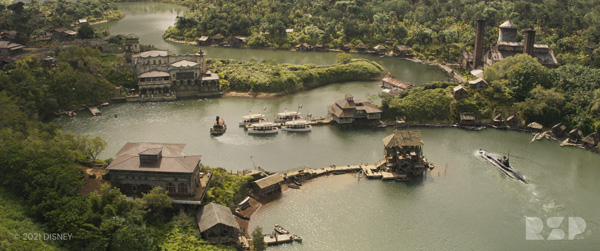
Two of the looks that define the adventure story in the new Disney film ‘Jungle Cruise’ are the Amazon Rainforest and the massive, magical Tree of Life. Here, the teams responsible from Rising Sun Pictures in Australia and DNEG in Canada and India talk about their work on these assets, plus explosions, water simulations and more.
Rising Sun Pictures (RSP) delivered 300 final VFX shots for the project. As the film was shot in Hawaii, the RSP team needed to recreate views of the Amazon rainforest where the Jungle Cruise story takes place. Their photo-real jungle environments are used in several scenes in the film, the tale of skipper Frank Wolff and medical researcher Lily Houghton as they pilot an ageing river boat named La Quila upstream in search of an ancient tree with miraculous healing powers.
Since the movie is inspired by Disney’s theme park ride Jungle Cruise, the audience is fully aware that Frank and Lily are going to encounter impossible dangers and supernatural forces – with mankind’s fate hanging in the balance. Working under production VFX Supervisor Jim Berney, over 100 artists from RSP were involved, devoting nearly a year to the project. They created not only the complex rainforest environments but also scenes of destruction, including explosions at an old Port town on the Amazon during an altercation with a submarine, and some creature animation.
Distinctively Amazon
RSP’s VFX Supervisor Malte Sarnes said, “The Amazon differs from other rainforests in the world and has very specific, recognisable species. It was important to get all the details right. Even the colour of the Amazon river is very distinctive – brown but not dirty to reflect its organic nature. We also produced more than 200 varieties of trees and distributed them procedurally across the landscape, consistent with the way they occur in real life. Our widest shot includes more than 10 million trees, bushes and other species.”
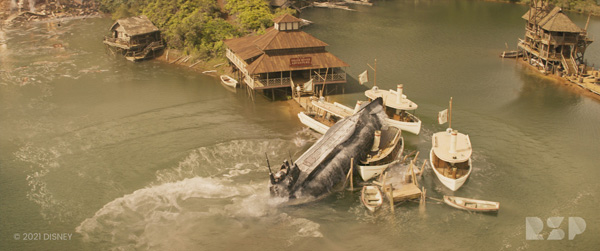
Matching the denseness and natural variety of the rainforest across both wide and close shots was extremely challenging. RSP studied the jungle’s terrain, flora and wildlife, and designed individual shots to match the diversity of the real world. The set location in the plates that stood in for the Port town’s jungle environment was the Kapaia Reservoir on the Hawaiian island of Kauai.
“We continued the curves and local topography of the Reservoir to create the serpentine rivers and jungles of the Amazon,” said CG Supervisor Jamie MacDougall.“Production provided us with excellent reference footage and we then conducted further research. It was essential to identify native plant species and also which are the most common.
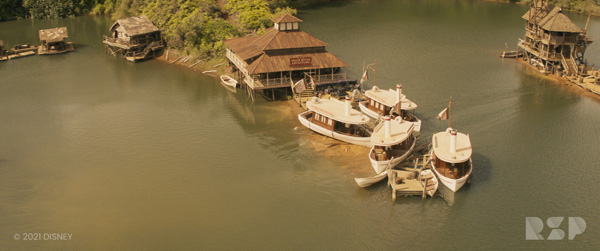
“The rainforest is, of course, overgrown and so trees are often covered by other things. One of the trickiest parts of these large scale set extensions was removing trees not native to the Amazon. This required integrating CG trees behind real ones – a real compositing nightmare. In some shots, the camera is quite close to the forest, and so we had to break away from instance-type repetition and do all the dressing with bespoke detail.”
Planting a Jungle
Since the different plant varieties would grow differently across the country, RSP used a set of in-house tools built in both Maya and Houdini to control the distribution and growth of the millions of plants that make up the jungle. “This process involved a combination of hand placed trees for key layouts, and generative distribution of large scale extensions. Then we fed these layouts through our custom instancer to allow us to render these massive data sets, which were further extended by our DMP team to create the vast expanse reaching into distant mountains.
After the studio’s 3D team built the foundation of the environments, compositors applied finishing touches that enhance the realism. “We added light reflecting off the water, bugs flying around and dew glistening on leaves so that you feel like you are in a hot, muggy environment,” said Compositing Supervisor Phil Prates. “In the opening shot, we’re flying through the jungle while light beams poke through the dense foliage to let you know that, up above, it’s a sunny day.”
River Layout

RSP’s most demanding sequence follows La Quila as she travels a stretch of river toward a rundown trading post. The team created the river and all jungle backgrounds in CG, and produced extensions for the practical set representing the port town. Then the artists placed the boat, which had been shot practically on blue screen, into the river and animated it as it passes through the locations in the different sequences.
They began by creating a layout of the river and the jungle in order to choreograph its journey. This journey needed to match the narrative of the story, but the boat also had to travel down the river in a logical manner, reacting to the current and leaving foam and wake based on its travel speed.
“We build all our locations and assets to scale, and plotted the shots out along the river to check that we had consistent speed and sensible positions for the action between La Quila and the submarine,” said Jamie. “By moving our tracked cameras to these locations, we could automatically witness our CG set from the places that made sense for the sequence.
Torpedo
As La Quila approaches the port town, a submarine arrives on the scene and fires a torpedo in her direction. The boat narrowly escapes, but the torpedo continues racing through the water until it explodes into the town, destroying it. For that reason, only a small portion of the town was practical. Most of it is a digital extension.
“We added a rubber factory, piers, riverside huts, a big wooden structure and anything else that needed to be blown apart when the torpedo hits,” Jamie said. “There’s also a floating shed that is struck by a boat and smashed, along with other structures and props. Frank's boat actually looked great in plate, shot on bluescreen. It didn't require much digital assistance – except when doing fun stuff like jumping torpedoes or smashing through the boat sheds. Then we stepped in with our CG version.”
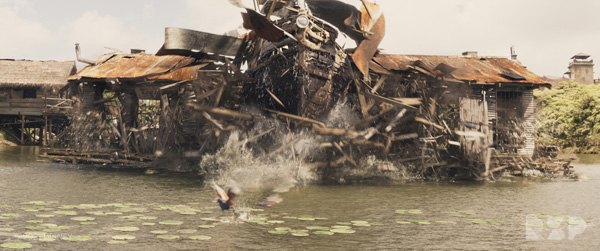
The submarine was handled differently. Built as a practical element, the sub was shot in a water tank, where pumps were used to create a water flow, though not as much as would be expected from a submarine operating in the Amazon. So, it was a matter of digital enhancement for RSP, extending the size and detail of the practical craft, and adding stock and CG elements to enhance the energy and drama of the shot. Finally, they ran simulations against their digital replica to make the spray, wake and reflections that sink it into the CG river surface.
Beautiful Blow-up
The scene required heavy effects simulations. Everything had to explode realistically and interact naturally with the water with ripples and swirls. “It’s beautiful stuff,” Jamie said. “The rubber factory explosion was a complicated bit of choreography. First, we follow the torpedo underwater as it launches, after La Quila (naturally) escapes by ramping up into the boat shed so the torpedo can pass underneath. The torpedo then strikes the factory just ahead of La Quila as she banks sharply to avoid the explosion.
“Since this beat is almost entirely CG, the process here involved a lot of plotting in layout and animation, finding timings and positions for the boat, submarine, torpedoes and cameras. Once the action was working across the shots, we ran simulations of the boat hitting the shed, the torpedo skimming the water, and then a giant internal explosion from inside the rubber factory. To finish, we augment these primary simulations with water spray, debris, dust and leaves kicked up by the shockwave that destroys the surrounding buildings and shakes the jungle.”

Uncomfortably Real
RSP’s work included a macabre scene in which a snake associated with Frank’s past agrees to a nefarious proposition. To give the supernatural scene its eerie quality, the snakes had to look and behave in an uncomfortably realistic manner. The artists first gathered reference material in order to fully understand snake movement and body types, and then accurately re-create the muscles rolling and bodies articulating despite the unnatural situation.
Ensuring the snakes appeared to react to the actor's dialogue while remaining snake-like required finesse. “We set to work early on to block the animation in shots to match the dialogue, which had been previously recorded,” said CG supervisor Ryan Kirby. “We needed to convey that the python could understand and agree with the actor, but not in a cartoonish way. It was all about getting the right nuance, injecting character while keeping it grounded in reality.”
Tree of Life
The team from DNEG, led by VFX Supervisor Christopher Downs, worked on 385 shots for ‘Jungle Cruise’. Produced by artists in Montréal, Vancouver and Mumbai, their work encompassed large parts of the movie’s third act. Joining the project fairly late, DNEG did not have the advantage of working with the filmmakers through pre-production. In fact, the project was 18 months into post when they started, and they needed to finish their work within eight months. Fortunately, the edit was fairly stable by that time.
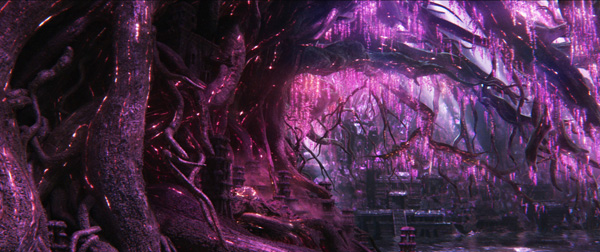
The scope of their work included a massive asset that forms the heart of the story – the magical Tree of Life, whose flowers cure illness, heal injuries and lift curses, according to legends spread by Spanish conquistadores. In Spanish the Tree has another name, Lágrimas de Cristal, which means Tears of Crystal, but Lily refers to it as Tears of the Moon, alluding to the backstory that it only blooms under a blood moon – that is, a lunar eclipse.
That story, in turn, relates to the Tree’s location inside a vast cavern that features the river running through it, and a roof with a circular opening positioned to let the moonlight shine in. An ancient city and temple also lie partly submerged below the cavern floor.
Concept Work

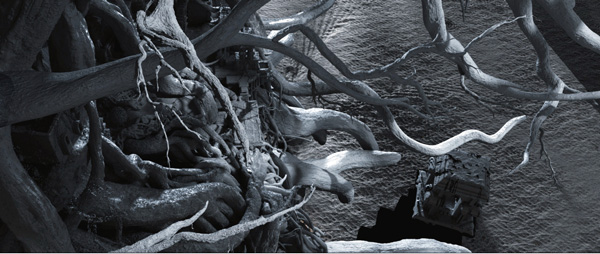
“When we joined the production, the design of the Tree of Life and its surrounding cavern environment were still unclear in the production’s vision, which gave our team a chance to work on the design of all of them. Starting with some initial previs, DNEG helped develop concept art to visualise a tree of great age and a majestic quality,” Chris said. Many kinds of trees were considered as reference – South American trees, of course, but also Asian banyan trees and baobab trees, which are African and sometimes called the Tree of Life. The artists aimed for gnarled looks, and bark textures that would allow incorporating the Tree’s magical veining.
DNEG also completed the city and temple. Their design was influenced by the archeological LiDAR scans taken a few years earlier of structures left behind by pre-Columbian cultures in Central America. As the moon is what triggers the growth and die-back of the Tree, the round opening in the roof for the moonlight also had to be designed to show its significance. The team added concentric rings of symbols around the hole, in line with the look of the temple and city.
Managing Complexity
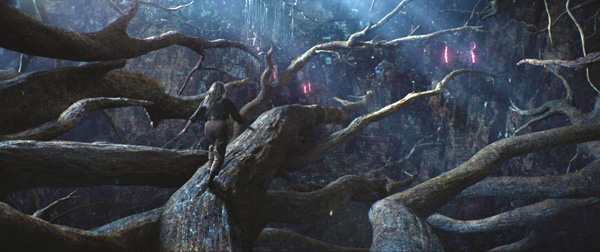

Design notwithstanding, a major challenge for DNEG was negotiating and managing the immense size of the project. “The Tree measures 500m across, composed of irregular, twisting branches, heavily textured bark and a network of veins,” said Chris. “The cavern is about 500m wide and 800m long, and the height up to the moon roof, seen from the arrival dock just after the Tree is revealed as Frank’s boat La Quila enters the cavern, is about 400m. By the end of the third act when the water level is significantly lower, the height is 100m taller from the base of the uncovered city.”
Due to its size and complexity, the DNEG team broke the Tree down into sections to suit the action, as well as to make the shots manageable for the artists and prevent bottlenecks during rendering. DNEG’s digital, environmental and other supervisors met with production VFX Supervisor Jim Berney to decide on the approach.
A hero tree was built for wide shots and rigged for growth animations. Then a section was built at closer range for the central portion of the Tree, serving as a digital set piece. They also identified a few key branches that needed to be completed to hero level, and finally added 15 or so extra branches that they would use to fill in the view, as required per shot.

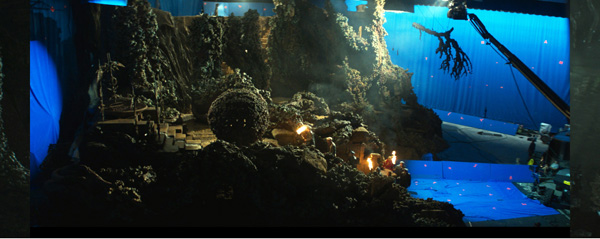
Because it encompasses the temple, city and moon roof, each with its own complex geometry, the level of detail shown of the cavern interior also had to be managed. Like the Tree, the cavern environment was divided up and completed according to the shots – any shot that contained a plate component was designed to match that component’s camera moves and angles, and any detail that did not serve that point of view was culled.
Chris mentioned that an on-going challenge for the team throughout this project was ingesting assets and other work handed off to them from other vendors on the film and preparing them for use in DNEG’s pipeline. “Different teams tend to finish their assets at different resolutions, supplying either under- or over-worked geometry relative to what our pipeline is set up for. It took time to get everything up- or down-rezzed to a format that would run smoothly,” he said.
Bloom

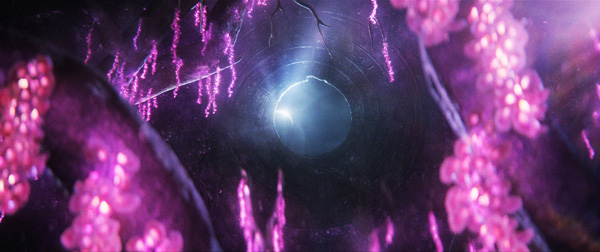
Toward the end of the story, the cast of villains and heroes converge on the Tree on the night of a blood moon. Its light shines through the moon roof, triggering a glowing pink bloom across the massive Tree.
The blooming was visualised as growing, flowering vines, instanced all over the Tree. The process was started by creating animation cycles for the vines that unfurl as the flowers open. Those vines, flowers and cycles were created in Maya. DNEG built about 10 variations of the cycles, and scattered them over the branches in a way that avoided duplication. The cycles were reversed for the dying process, however, the die-back had to be choreographed in accordance with the gradual passing of the rays of moonlight across the Tree, calling for a simulated effect in Houdini. The die-back was concepted in 2D and, when the animation was defined, translated into 3D shots.

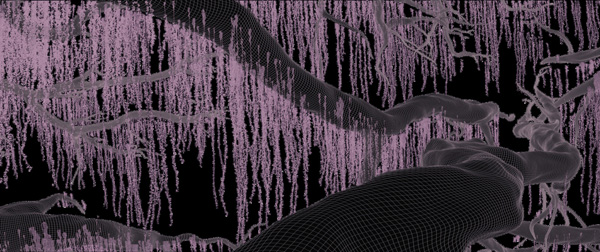
Associated with the bloom was the glowing light shining from inside the Tree, first growing brighter and then fading back again, giving it a magical look. This light, which ties the animation and simulations together, was created in Clarisse. Grooves had been designed into the bark to reveal the underlying veins that defined the internal lighting. Chris said, ‘The lighting inside the cavern is basically a combination of light of the moon streaming in through the moon roof, the glow from the petals that are blooming or have bloomed and the veins in the Tree. As the petals were the main light source, that light was used for interactive lighting onto the set and actors.’
Rushing River
DNEG created the river water in the cavern, handling water in motion interacting with CG and real assets and itself. Throughout the sequence, the level of the water continuously sinks after one of the characters diverts the river, causing the look of the water to change from beginning to end. The team created a range of different water simulations, created in Houdini, and placed them into categories.
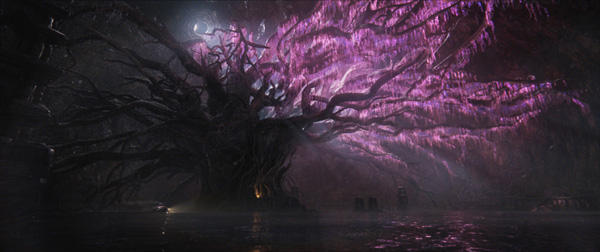
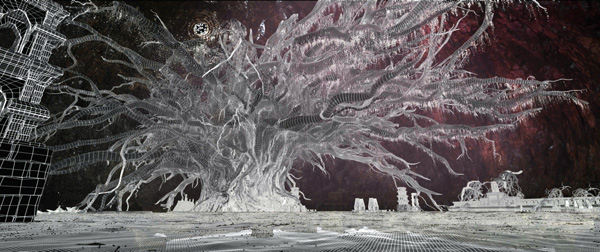
In the story, the river flows placidly at first and then begins to encounter trees, running off in drips. Toward the end of the sequence the simulations needed to be shown flowing together, creating turbulence as the water flows out of the cavern.
The rate of subsidence had to be steady and consistent, which was tricky because if any shots were moved in the cut for storytelling, after the water had been added, the water level would have to be adjusted as well. A CG wet map was devised to show the artists where the water had been in the shots ahead of the one they were working on. When the edit was final, they could refine the water with foam and bubbles.
Deep Images
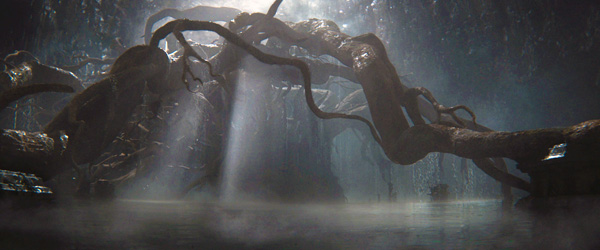
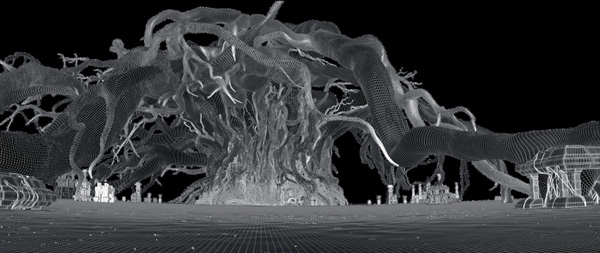
Deep compositing helped set up and adjust compositions involving a number of complex assets, especially once the water simulations became large and numerous enough to start interacting with each other, with tree branches or cavern geometry. Normally, a composite involving a lot of interacting elements needs a series of holdout mattes. If the artists decide to remove, move or add elements, the adjustments become complicated.
But deep images contain enough 3D information so that tasks such as rotoscoping large series of holdouts for complex interactions between moving objects and volumes – like the boat, large branches and the water simulations – that are normally very labour-intensive, become a lot easier. A number of mattes could be generated from one set of deep images without having to re-render every matte element and background each time. Typically, deep images also give a higher quality result when rendering motion-blurred edges or semi-transparent elements like water simulations. www.rsp.com.au www.dneg.com


















